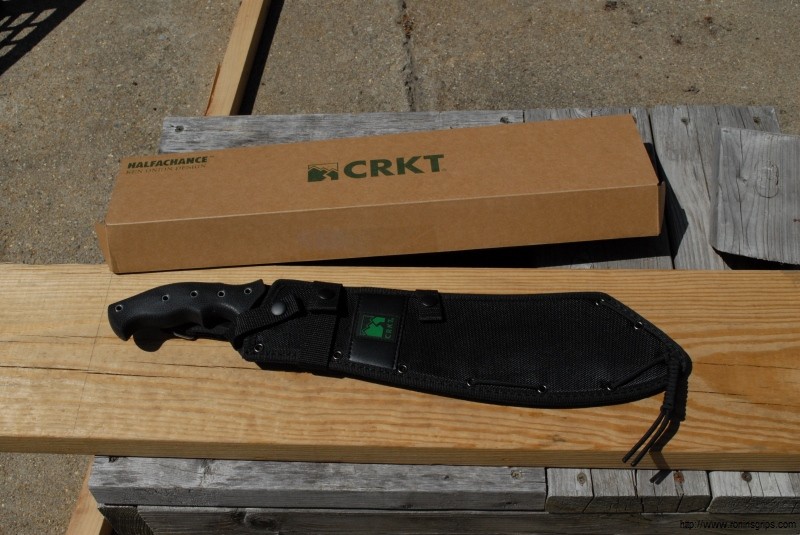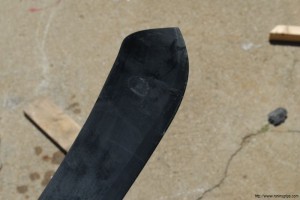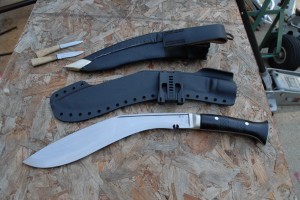

I have a thing for machetes. Why, I do not know. Over the years I have owned quite a few and have a number of them in my garage from various manufacturers and blade profiles. I am accumulating chronic injuries almost as fast as I am blades it seems. I have two torn rotator cuffs, tendonitis in my elbows and carpal tunnel in both hands after years of abuse. Luckily, I can swing a machete albeit slower than I used to and trying to hold on to the handle plus the impacts usually combine to make my hands stiff and wrists ache. Let’s face it – machete handle design hasn’t changed much in decades.
Now, I like Ken Onion as a knife designer. I read about his new HalfAChance Parang-style machete (CRKT # K920KKP) and that it had an ergonomic handle. This intrigued me. I was first in line to buy his big Redemption knife but while he had the basic shape right, the handle was too small for such a big blade so I sold it. That didn’t turn me off to his designs though – I probably own at least six Ken Onion designs so I know he knows his stuff. At any rate, I went ahead and ordered one of the HalfAChance machetes from Amazon and two days later the box arrived. I opened it and there sat the big machete in an even bigger nice Nylon sheath but I immediately looked at the handle – it was big and had a textured rubber over some solid core. I picked it up and it felt great!
Notice the natural angle to the handle. I wear XL sized gloves and you can see the handle fits my hand nicely. The first photo is of it in my left hand and the second photo is of it in my right hand. The overmolded rubber feels great.



I immediately went out and chopped on a sassafrass tree I had recently dropped and the HalfAChance bit in deep easily. I mean it really penetrated – way more than I expected. I think this was due to the relatively thin 0.1″ thick 65Mn Carbon Steel they used with a flat grind. Guys, I chopped the limb off and then chopped some more – it was really easy. I didn’t go hog wild but I can tell you that normally my hand would hurt and it did not. The design helped me hold the big blade and the rubber really helped with the impact. Look at the results of a few minutes of work:



By the way, I also noticed they did a great job on the finish. It is a powder coat over a bead blast and despite the chopping, it was in great shape. I saw some dirt and it rubbed right off. It held up a lot better than I expected – no sign of flaking.



After testing the HalfAChance for a bit, I was interested in comparing the CRKT Parang to my Condor Parang. The Condor is very well made and has a nice curved handle. It’s blade was dull so I took the time to put a nice working edge on it first. I also took a 15 minute break to make sure my hand wasn’t unduly stressed to be fair to the Condor.



Well, the Condor didn’t fare very well to be honest. In the same 5-6 strikes, the Condor did not penetrate as much and the jarring impacts through the wood handle made my hand start to cramp. I think this is because Condor used a much wider blade – almost 1/4″ (6mm actually) 1075 High Carbon steel. It has great heft and a short top to bottom profile but it is just too thick. Look at the difference in results and I tried to use the same number of cuts and force – the left cut was done by the CRKT HalfAChange and the right with the Condor:


So, to me, the winner and new go-to machete it the CRKT Parang hands down. It cuts and feels great. CRKT and Ken Onion did a great job on this one. Of course, I will have to now order and try the other machete they released, the ChanceInHell!
In case you are interested in specs for the HalfAChance, the following is from the CRKT website:
| Dimensions |
| Open Overall Length |
19.5 inches |
| Weight |
1 lb. 4.4 ounces |
| Blade |
| Length |
14 inches |
| Thickness |
0.1 inches |
| Material |
65Mn Carbon Steel |
| Blade-HRC |
52-56 |
| Finish |
Bead Blast then Black Powder Coating |
| Grind |
Flat |
| Style |
Drop Point Parang |
| Edge |
Plain |
| Handle |
| Material |
PP Core & TPR Overmold Black with Faux Pigskin Texture |
| Carry |
| Carry System |
Black Nylon Sheath |
| Weight |
6.1 ounces |
October 2017 Update – took this on our annual brush clearing trip just before Halloween on property we own and it worked great as usual. After dozens and dozens of branches, saplings and briars, it is still holding up great. It is still my preferred machete and use it probably 3-4x per season.
2/27.20 Update: It’s holding up great and is still my preferred machete for clearing stuff.
If you find this post useful, please share the link on Facebook, with your friends, etc. Your support is much appreciated and if you have any feedback, please email me at in**@*********ps.com. Please note that for links to other websites, we are only paid if there is an affiliate program such as Avantlink, Impact, Amazon and eBay and only if you purchase something. If you’d like to directly contribute towards our continued reporting, please visit our funding page.
Like this:
Like Loading...

































